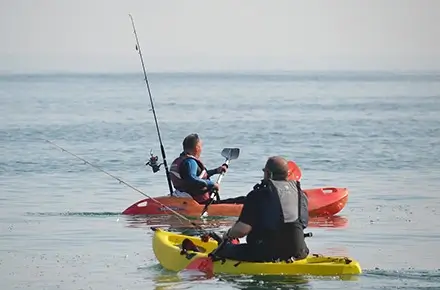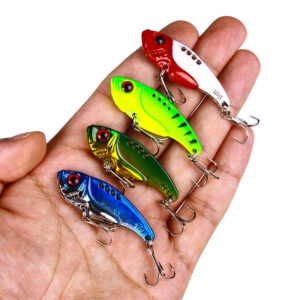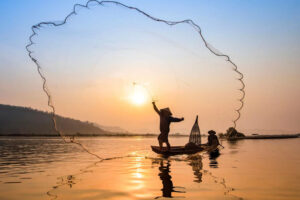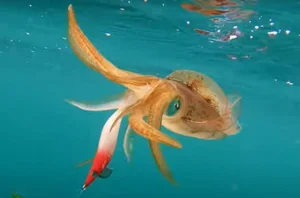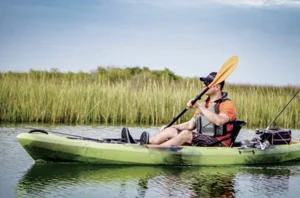It sounds fascinating! But, Kayak: What is it?
In most cases, paddlers use a double-bladed paddle to propel a small, narrow kayak. Fishing fans choose it since it’s easy to maneuver lakes and rivers, among other bodies of water. If you enjoy fishing, you may be able to visit new fishing locations by using a kayak.
Fishkool: What is it?
Fishkool strives to give both commercial and recreational fishermen enjoyable fishing experiences. We offer premium gear at reasonable prices. We value the family and the coming generation. We encourage and support youth involvement in the local fishing community.
How does a kayak work?
A kayak is a type of small boat that is usually rowed using two paddles. Operating a kayak is simple. Knowing the fundamentals improves your kayaking experience. The general operation of a kayak is as follows:
1. Design:
Kayaks come in various designs, but they generally share common features. The bottom part of the kayak called the hull, is super important for keeping it steady and making it work well. The deck is the top part of the kayak.
2. Buoyancy:
Designers create kayaks to displace water and maintain buoyancy. The shape of the hull affects how well the boat floats and stays balanced. Designers create kayaks to float on the water. The buoyant force supports the weight of the paddler and gear.
3. Paddling:
Paddlers propel kayaks by using a double-bladed paddle. The paddler sits facing forward. By alternating strokes on either side of the kayak, they can move forward. Make sure your paddling technique is smooth and efficient.
4. Steering:
You achieve steering a kayak through paddle strokes. To turn left, you paddle on the right side, and vice versa. Kayaks can also have cool stuff. For example, they may have foot-controlled rudders to help with steering. This is especially helpful when it’s tricky out on the water.
5. Consistency:
A kayak’s width, hull design, and paddling style all affect its stability. Smaller kayaks can have better secondary stability. Wider kayaks often have stronger initial stability. Keeping your back straight is super important. Ensure that you distribute your weight to maintain stability.
6. Types of Kayaks:
There are different types of kayaks designed for specific activities. Sit-on-top kayaks are super chill and stable. They are perfect for newbies and for paddling in warm weather. Sit-inside kayaks offer more protection from the elements. People use them for touring. Fishing kayaks have cool stuff like rod holders and storage for all you anglers out there.
7. Special Features:
Some kayaks have special features. These include pedal-driven propulsion systems or electric motors for added convenience. These features can improve the kayaking experience. They also offer different ways to move the kayak.
8. Safety:
Understanding safety aspects is crucial for a safe kayaking experience. This includes using personal flotation devices (PFDs). It also involves being aware of water conditions.
Remember, kayaking skill improves with practice. If you’re kayaking for recreation, fitness, or fishing, it’s important to be comfortable with the basic mechanics of kayaking. This will make your outings more enjoyable and safe. If you’re new to kayaking, consider taking a lesson. You can also paddle with experienced individuals to learn proper techniques.
Is the kayak safe and friendly to the environment? Can you tell me the process of making a kayak?
Crafting a kayak involves several steps. It’s crucial to ensure safety and environmental friendliness. Here’s a detailed walk-through:
1. Feeding:
The manufacturing process feeds raw materials, high-density polyethylene (HDPE), into it. Choosing materials and recycling whenever possible is key to environmental friendliness.
2. Install Screws:
Assemblers assemble components and install screws. Ensuring proper installation techniques minimizes the risk of accidents during the kayak’s use.
3. Mold Locking:
A mold secures the assembled parts. Proper locking ensures the kayak takes the desired shape during the manufacturing process.
4. Heating Mold:
Heating the mold to the appropriate temperature allows the material to take the shape of the kayak. Efficient heating methods help save energy.
5. Moving into the Oven:
An operator moves the mold, with the kayak components, into an oven. Using energy-efficient ovens and processes reduces the environmental impact.
6. Baking & Seesaw:
The kayak undergoes baking to set its form. Some manufacturing processes use a seesaw mechanism to distribute heat. This ensures consistency in the kayak’s structure.
7. Open the Oven for Inspection:
Quality inspection opens the oven. Check for defects and ensure the kayak meets safety standards.
8. Remove the Mold:
After setting the kayak, we remove the mold. Careful handling at this stage prevents damage to the kayak. It also ensures worker safety.
9. Mold Cooling:
The mold and kayak cool down. Using controlled cooling methods helps maintain the structural integrity of the kayak. Keeping the mold in a certain room also reduces environmental damage.
10. Mold Unlocking:
After cooling, the mold unlocks and prepares the kayak for the next steps.
11. Remove the Hull:
The mold separates the kayak hull. Proper handling at this stage prevents any potential hazards.
12. Final Inspection:
The kayak undergoes a thorough final inspection. This is to ensure it meets safety and quality standards. We make any necessary adjustments.
13. Surface Cleanup:
Clean the kayak’s surface to remove any residues. Using friendly cleaning agents minimizes the impact on the surroundings.
14. Surface Repair:
Using repair methods, we address any imperfections that we find.
15. Assemble Components:
We assemble various components of the kayak, such as seats and hatches. Precision in assembly is important for safety.
16. Packaging:
We package the finished kayak. Using recyclable materials for packaging aligns with practices.
Here is a video showing the process of making a kayak in detail:
What kayak is best for fishing?
Choosing the best kayak for fishing depends on various factors. These include your preferences, fishing style, and the water conditions you’ll encounter.
1. Solo or Tandem:
If you prefer fishing solo, a single-person kayak might be ideal. For those who enjoy fishing with a companion, a tandem kayak provides shared angling experiences.
2. Kayak Type:
Sit-on-top kayaks offer easy entry and exit, making them great for fishing. Sit-inside kayaks provide a more enclosed cockpit, suitable for colder conditions.
3. Stability:
Look for a kayak with excellent stability, especially if you plan to stand while fishing.
4. Storage and Accessories:
Consider the storage options and accessories available.
5. Maneuverability:
Depending on where you plan to fish, maneuverability is crucial.
6. Durability:
Ensure the kayak is durable and can withstand the conditions you’ll encounter. Fishkool crafts kayaks from high-quality materials. They provide durability for both freshwater and saltwater fishing.
7. Transportation and Storage:
Consider the size and weight of the kayak, especially if you have to transport it. Fishkool designs their kayaks for portability, making them easy to transport and store.
8. Budget:
Determine your budget and find a Fishkool kayak that offers the features you need within that range. Fishkool provides a variety of options to suit different budget considerations.
Which is the best kayak for beginners?
For beginners, a kayak with stability, ease of use, and versatility is a great choice.
1. Stability:
A steady platform for beginners is crucial for building confidence. This is especially true for those who may be new to paddling.
2. Easy Entry and Exit:
The kayak should feature a design, that makes it easy for beginners to enter and exit the kayak. Individuals new to kayaking should pay special attention to this.
3. Maneuverability:
The kayak should offer decent maneuverability. This allows beginners to navigate different water conditions without feeling overwhelmed. It needs a good balance. The kayak needs to provide enough control without being responsive.
4. Comfort:
Comfort is key for beginners spending extended periods on the water. The kayak should have a comfortable seating arrangement. This will make it easy for beginners.
5. Affordability:
For those starting, budget considerations are often important. The kayak should be available and of high quality.
6. Durable Construction:
You should build the kayak with durability in mind. This ensures it can withstand the learning curve that comes with being a beginner. Individuals who are still improving their kayaking skills can enjoy this.
7. Features:
The kayak should come with features like built-in rod holders. It should also have convenient storage options. It should cater to the needs of anglers while keeping things simple for those new to the sport.
Before making a final decision, beginners should try out different models if possible. It’s always a good idea. What’s more, it is useful to read user reviews and seek advice from experienced kayakers. Remember that the best kayak for a beginner aligns with individual preferences. Consider the specific type of kayaking and fishing activities you plan to pursue.

